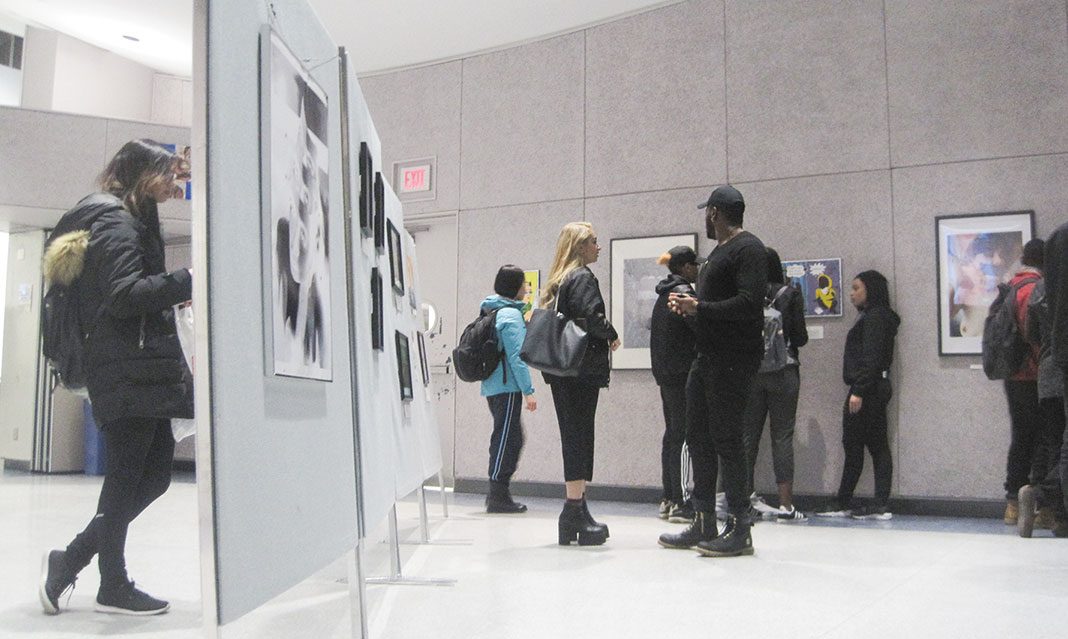Art is a universal tool that transcends social boundaries. It allows us to share thoughts, opinions, and messages that we might otherwise keep to ourselves. In a student environment, it’s essential to have an outlet for artistic expression. Moreover, it’s imperative that student communities support each other throughout this expressive process.
Caribbean Connections and UTM Scribes sought to provide such an outlet at their student-run art show last Monday. The Platform created an opportunity for U of T students from all three campuses—there were even participants from York University—to display their work for the public. R.I.S.E., a Scarborough-based community of artists and activists, co-hosted the event.
The Platform showcased sketches, paintings, framed poems, photography, and other mixed media pieces in the Presentation Room of the Student Centre. Further into the evening, the doors to the Blind Duck opened for presentations from artists. Several artists on display offered explanatory presentations on their work. Others used the stage as a platform in itself, either through dance, song, or spoken word poetry.
“[At UTM], we need something by the community of students, for the community of students. That’s what The Platform is,” says Tobi Ogude, a third-year DEM student and member of Caribbean Connections. “It’s an opportunity to bring forth artwork that maybe you haven’t been comfortable showing people before. This is the platform to do it.”
The Student Centre was an ideal location for The Platform—what better place to host a student-run art show than UTM’s hub for student life? As the evening progressed, visitors came to circulate the display and absorb the talent of our demographic.
Sujaya Devi’s diptych photography particularly intrigued me, both aesthetically and conceptually. The piece features a single strip of imagery running horizontally through the white background. The strip depicts three different scenes of three different people. Each scene uses a mirror effect to show two versions of the same person. The two versions have different moods, with each mood cast in a contrasting colour. The model on the left, for instance, avoids eye contact and frowns, while her “mirror image” looks into the camera and smiles. A blue tint characterizes the sad version, while a yellow tint characterizes the happy version. “This series aims at attracting opposites and merging them to create balance. When complimentary colours are combined, they create a harmonious balance,” Devi comments in her note on the piece.
Artwork hung on both the walls and several panels that were rolled in for the occasion. Like Devi, many artists crafted their pieces with a specific purpose or commentary. Erika Johnson’s triptych series, “Dad,” addresses racial stereotypes in father-child relationships. The three paintings illustrate different racial relationships and their accompanying stereotype. Johnson painted her series in a graphic novel style, with bright, vibrant colours and text bubbles above the characters’ heads. The colourful imagery and text bubbles immediately invited me towards the series.
The first piece portrays an Asian father and daughter, representing the stereotypical strictness of Asian parents. The second piece is divided in half, with a Black father behind bars on the left and his crying baby on the right. This piece confronts the stereotype of absent and/or criminal Black fathers. The final piece depicts a white father’s poor attempt to reprimand his bratty son, who swears at his father and demands cookies. The text bubbles above their heads show the father’s passive dialogue and the son’s rude commands. This third piece comments on the stereotype of spoiled white children and the parents’ inability to discipline them. Johnson writes in her note on the series, “My triptych is meant to encourage discussion about racial prejudice that still exists today.”
Indeed, The Platform offered students a safe space to raise issues and pose commentary, such as Johnson’s critique of racial stereotypes.
“The purpose behind The Platform is to provide people with an open space,” Ogude remarks. “We live in a society where there’s not a lot of safe spaces and there’s not a lot of places to simply look at art and appreciate different types of work ethics, different types of skills, and different types of talents. This is a place where students can shine.”



